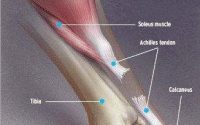跟腱炎——Achilles Tendinosis
Achilles Tendinosis
What is Achilles tendinosis?
When the Achilles tendon degenerates and become inflamed, the condition is called Achilles tendinosis. The tendon can swell and may cause pain. This condition is common in athletes, runners and patients who have calf tightness. Achilles tendinosis may occur in the middle of the tendon. This is known as midsubstance Achilles tendinosis. It may also occur at the point where the tendon connects to the heel bone. This is known as insertional Achilles tendinosis.
What are the symptoms of Achilles tendinosis?
Many changes can be seen when the Achilles tendon becomes inflamed. Patients have pain and/or tightness in the tendon behind the ankle. Most of the time there is no trauma or injury, but rather a slow progression of pain. Patients may have difficulty climbing stairs or running. Patients may also have pain after sitting for long periods or after sleeping. Many patients will notice a bump either in the tendon (midsubstance Achilles tendinosis) or right behind the heel bone (insertional Achilles tendinosis). Some may also get irritation from shoes rubbing against the bump and feel better when wearing backless shoes. Patients also commonly have less pain while wearing a shoe with a slight heel versus shoes that are flat.
What causes Achilles tendinosis?
Achilles and calf tightness is a common cause of Achilles tendinosis. In addition, insertional Achilles tendinosis is often associated with a heel bone spur. This spur may rub against the Achilles tendon and lead to breakdown and small tears. It is similar to a rope being rubbed against a sharp rock. This is also known as Haglund’s Syndrome. Pain and swelling occur as the cumulative effects of chronic wear and tear on the tendon.
How is Achilles tendinosis diagnosed?
A thorough history is taken and an examination is performed. Patients will usually have pain right on the tendon or at the back of the heel. They may also have swelling and thickening of the tendon. X-rays may be taken to see if there are any bone spurs. An MRI or ultrasound may also be performed to further evaluate how much of the tendon is affected and to look for any tears.
What are treatment options?
Treatment depends on the length and severity of the symptoms. Many patients improve without surgery. Rest and oral medications may help reduce the swelling and pain. Heel cups can improve pain by taking some of the stress off of the Achilles tendon when walking. A walking boot or other brace may be recommended.
Often formal physical therapy is recommended to work on stretching and improve mobility within the calf muscle. Other treatments may include ultrasound, massage, shockwave therapy and topical nitroglycerin patches. Recently, platelet rich plasma has been discussed as a treatment for Achilles tendinosis. This involves taking one’s own blood and isolating growth factors that are involved in healing. This serum is then injected into the inflamed tendon.
In some cases, surgery may be required. The specifics of the surgery depend upon the location and extent of the tendinosis.
Frequently Asked Questions
If I am treated without surgery for Achilles tendinosis will it come back?
While most patients will achieve lasting relief after treatment for Achilles tendinosis, symptoms may return. The risk decreases if the patient continues to do routine stretching even after the symptoms resolve. However, athletes and runners in particular are at a slightly higher risk for this condition because of the high demands on the Achilles. These patients should pay close attention to stretching and shoewear to prevent chronic recurrence.
What are the outcomes for those who have surgery for Achilles tendinosis?
Surgery can predictably return patients to activity. Success rates have been reported between 80 and 90 percent, which means that eight to nine out of 10 people improve with surgery. Some of the variability depends on the amount of tendon that is diseased at the time of surgery.
Patients improve with both conservative and operative management of Achilles tendinosis. Physical therapy has been shown to help most patients with this condition and should be tried before surgical management is proposed.
跟腱炎
什么是跟腱病?
当跟腱退化和发炎时,这种情况被称为跟腱病。肌腱会肿胀并可能引起疼痛。这种情况常见于运动员、跑步者和小腿紧绷的病人。跟腱病可能发生在肌腱的中间。这被称为 “中段跟腱炎”(midsubstance Achilles tendinosis)。它也可能发生在肌腱与跟骨的连接点。这被称为插入性跟腱炎。
跟腱病的症状是什么?
当跟腱发炎时,可以看到许多变化。患者的脚踝后面的肌腱有疼痛和/或紧绷感。大多数情况下,没有外伤或损伤,而是疼痛的缓慢发展。患者可能有爬楼梯或跑步的困难。患者也可能在长时间坐着或睡觉后出现疼痛。许多患者会注意到肌腱上有一个凸起(中段跟腱炎)或就在跟骨后面(插入型跟腱炎)。有些人还可能因鞋子摩擦凸起而受到刺激,在穿露背鞋时感觉更好。患者在穿有轻微鞋跟的鞋时,与穿平底鞋时相比,疼痛也普遍减轻。
什么原因导致跟腱炎?
跟腱和小腿紧张是造成跟腱炎的常见原因。此外,插入性跟腱炎通常与跟骨骨刺有关。这种骨刺可能会摩擦跟腱,导致肌腱破裂和小的撕裂。这类似于一根绳子被尖锐的石头摩擦的感觉。这也被称为哈格伦德(Haglund)综合征。疼痛和肿胀的发生是肌腱慢性磨损的累积效应。
如何诊断跟腱病?
要彻底了解病史并进行检查。患者通常会在肌腱右侧或脚后跟处出现疼痛。他们还可能有肿胀和肌腱增厚。可以拍X光片,看看是否有任何骨刺。也可以进行核磁共振或超声波检查,以进一步评估肌腱受影响的程度,并查看是否有撕裂。
有哪些治疗方案?
治疗方法取决于症状的长度和严重程度。许多病人不需要手术就能改善。休息和口服药物可能有助于减轻肿胀和疼痛。足跟垫可以在行走时减轻跟腱的一些压力,从而改善疼痛。可能建议使用步行靴或其他支架。
通常情况下,建议采用正式的物理治疗,以拉伸和改善小腿肌肉的流动性。其他治疗方法可能包括超声波、按摩、冲击波疗法和外用硝酸甘油贴片。最近,人们讨论了富血小板血浆作为跟腱病的治疗方法。这涉及到抽取自己的血液并分离出参与愈合的生长因子。然后将这种血清注射到发炎的肌腱中。
在某些情况下,可能需要进行手术。手术的具体细节取决于肌腱炎的位置和程度。
常见的问题
如果我不通过手术治疗跟腱炎,它是否会复发?
虽然大多数病人在治疗跟腱炎后会获得持久的缓解,但症状可能会复发。如果患者在症状缓解后仍继续做常规拉伸运动,风险就会降低。然而,由于对跟腱的要求很高,运动员和跑步者患此病的风险尤其高。这些患者应密切注意拉伸和鞋袜,以防止慢性复发。
对跟腱炎进行手术治疗的人的结果如何?
手术可以预见地使患者恢复活动。据报道,成功率在80%到90%之间,这意味着10个人中有8到9个人通过手术得到改善。一些差异性取决于手术时肌腱的病变量。
跟腱病的保守治疗和手术治疗都能使患者得到改善。物理治疗已被证明可以帮助大多数患有这种疾病的病人,在建议进行手术治疗之前,应该尝试物理治疗。



